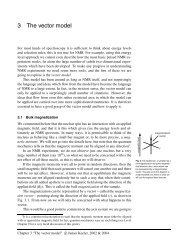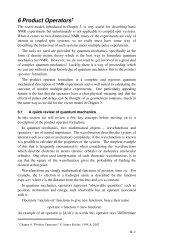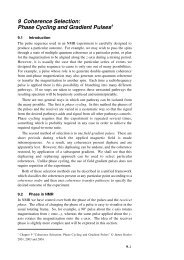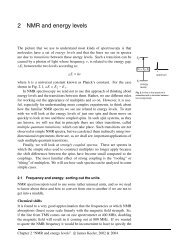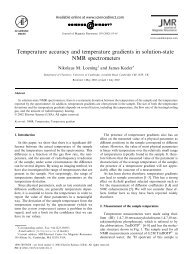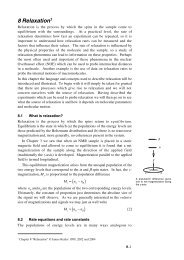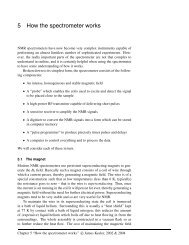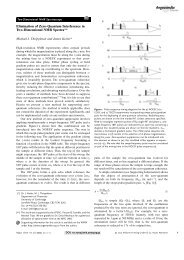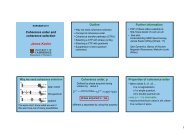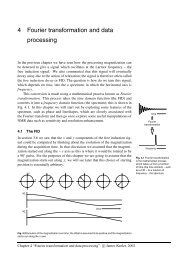Phase Cycling and Gradient Pulses - The James Keeler Group
Phase Cycling and Gradient Pulses - The James Keeler Group
Phase Cycling and Gradient Pulses - The James Keeler Group
You also want an ePaper? Increase the reach of your titles
YUMPU automatically turns print PDFs into web optimized ePapers that Google loves.
t 1<br />
τ mix t 2<br />
1<br />
0<br />
–1<br />
If we group the first two pulses together they are required to achieve the<br />
transformation ∆p = 0 <strong>and</strong> this leads to a four step cycle in which the pulses go<br />
0 1 2 3 <strong>and</strong> the receiver remains fixed as 0 0 0 0. In this experiment axial<br />
peaks arise due to z-magnetization recovering during the mixing time, <strong>and</strong> this<br />
cycle will not suppress these contributions. Thus we need to add axial peak<br />
suppression, which is conveniently done by adding the simple cycle 0 2 on the<br />
first pulse <strong>and</strong> the receiver. <strong>The</strong> final 8 step cycle is 1st pulse: 0 1 2 3 2 3<br />
0 1, 2nd pulse: 0 1 2 3 0 1 2 3, 3rd pulse fixed, receiver: 0 0 0 0 2 2<br />
2 2.<br />
An alternative is to cycle the last pulse to select the pathway ∆p = –1, giving<br />
the cycle 0 1 2 3 for the pulse <strong>and</strong> 0 1 2 3 for the receiver. Once again, this<br />
does not discriminate against z-magnetization which recovers during the mixing<br />
time, so a two step phase cycle to select axial peaks needs to be added.<br />
9.5.9.3 Heteronuclear Experiments<br />
<strong>The</strong> phase cycling for most heteronuclear experiments tends to be rather trivial<br />
in that the usual requirement is simply to select that component which has been<br />
transferred from one nucleus to another. We have already seen in section 9.2.8<br />
that this is achieved by a 0 2 phase cycle on one of the pulses causing the<br />
transfer accompanied by the same on the receiver i.e. a difference experiment.<br />
<strong>The</strong> choice of which pulse to cycle depends more on practical considerations<br />
than with any fundamental theoretical considerations.<br />
<strong>The</strong> pulse sequence for HMQC, along with the CTP, is shown below<br />
I<br />
∆<br />
∆<br />
t 2<br />
S<br />
1<br />
p I 0<br />
–1<br />
1<br />
p S 0<br />
–1<br />
t 1<br />
Note that separate coherence orders are assigned to the I <strong>and</strong> S spins.<br />
Observable signals on the I spin must have p I<br />
= –1 <strong>and</strong> p S<br />
= 0 (any other value<br />
of p S<br />
would correspond to a heteronuclear multiple quantum coherence). Given<br />
this constraint, <strong>and</strong> the fact that the I spin 180° pulse simply inverts the sign of<br />
p I<br />
, the only possible pathway on the I spins is that shown.<br />
<strong>The</strong> S spin coherence order only changes when pulses are applied to those<br />
spins. <strong>The</strong> first 90° S spin pulse generates p S<br />
= ±1, just as before. As by this<br />
point p I<br />
= +1, the resulting coherences have p S<br />
= +1, p I<br />
= –1 (heteronuclear<br />
zero-quantum) <strong>and</strong> p S<br />
= +1, p I<br />
= +1 (heteronuclear double-quantum). <strong>The</strong> I spin<br />
9–31



